New York
About Andrew Cusack
 Writer, web designer, etc.; born in New York; educated in Argentina, Scotland, and South Africa; now based in London.
Writer, web designer, etc.; born in New York; educated in Argentina, Scotland, and South Africa; now based in London. read more
News
Blogs
Reviews & Periodicals
Arts & Design
World
France
Mitteleuropa
Knickerbockers
Argentina
The Levant
Africa
Cape of Good Hope
Netherlands
Scandinavia
Québec
India
Muscovy
Germany
Academica
Onze Grootste President
The London Residence of President Martin van Buren
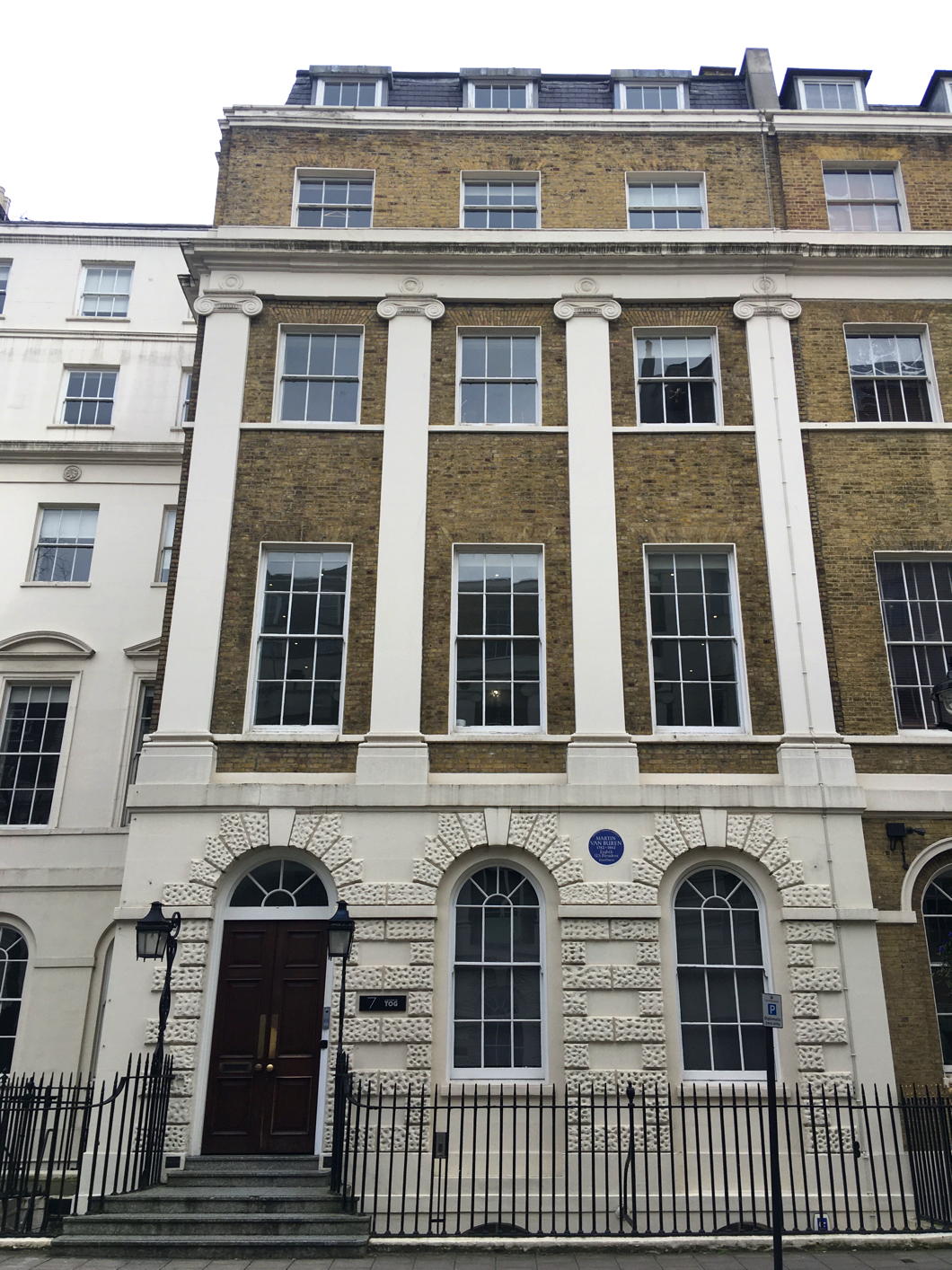
Transacting some business in March before the plague struck us here in London I found myself with a moment to spare and made a brief pilgrimage to No. 7, Stratford Place. It was in this handsome townhouse that Martin van Buren, the first New Yorker to ascend to the chief magistracy of the American Republic, had his residence when he served as the United States’s minister to Great Britain in 1831.
While I often claim that Calvin Coolidge was America’s greatest president in reality my chief devotion in that contest is to the Little Magician himself, the Red Fox of Kinderhook.
Among the many characteristics of this esteemed Knickerbocker is that English was not his native language and throughout his career as a democratically elected politician he spoke with a thick Dutch accent. To his wife, he spoke almost entirely in Dutch.
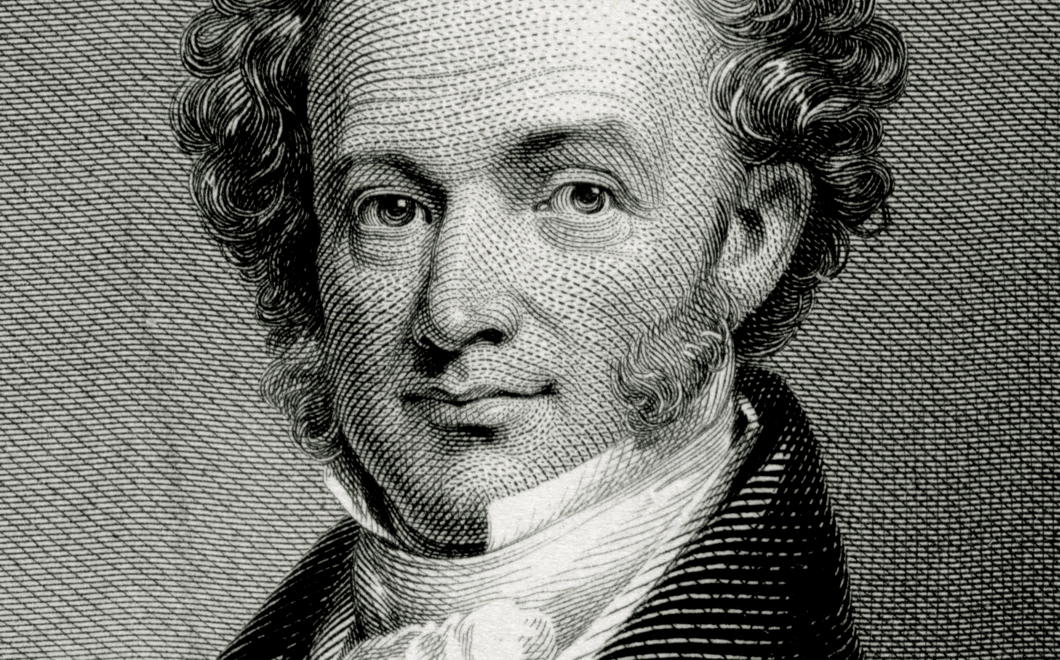
Jay Cost and Luke Thompson’s Constitutionally Speaking podcast at National Review recently released the first of a two episodes about van Buren and while I’m no fan of podcasts in general this was worth listening to.
One of the factors Cost and Thompson highlight is the utility of the party machine structures of the day in solidifying the practice of America’s democracy and acting as a vehicle of accountability, something too little appreciated by most later observers of the period.
We keen Kinderhookers and Van Buren Boys await the second instalment with anticipation.
Shamefully I have not yet made the pilgrimage to Kinderhook itself, but it’s pleasing to learn that the dominie of the Dutch Reformed Church is a graduate of the greatest university in the southern hemisphere.
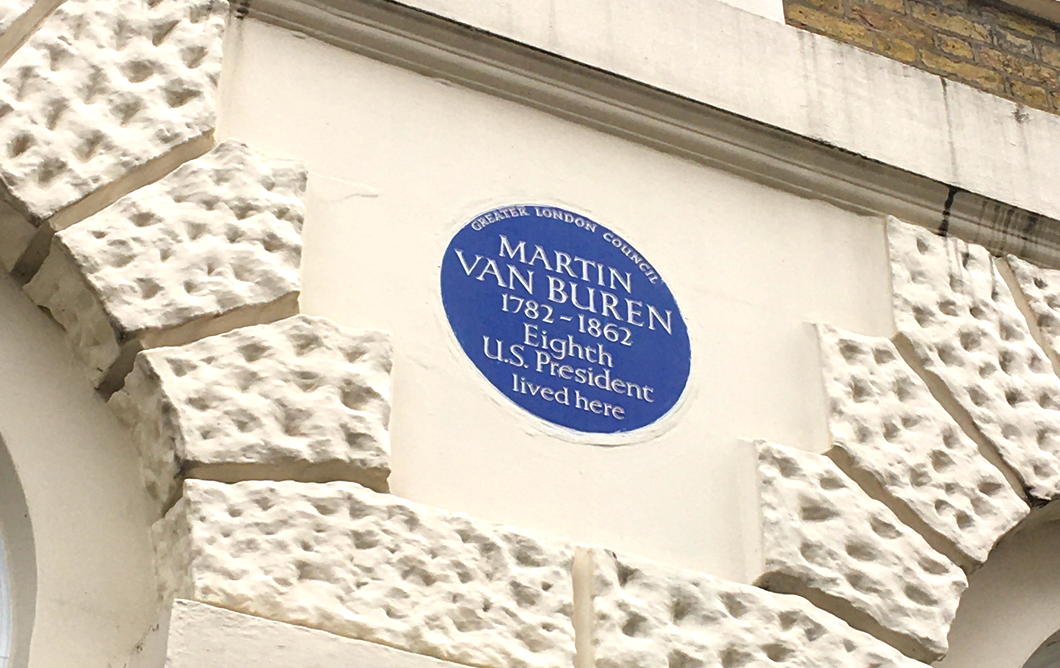
How Our Ancestors Built
The Hudson River Day Line Building in Albany
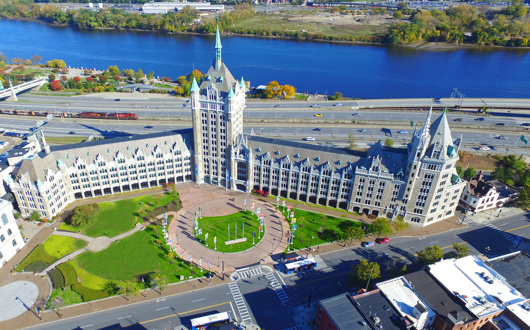
The visitor arriving at Albany, the capital of the Empire State, might be forgiven for presuming the riparian French gothic mock-chateau he first views is the most important building in town.
Built as the headquarters of the Delaware & Hudson, a canal company founded in 1823 that successfully transitioned into the railways, the chateau now houses the administration of the State University of New York. (Indeed, the Chancellor once had a suitably grandiose apartment in the southern tower.) That building, with its pinnacle topped by Halve Maen weathervane, is worthy of examination in its own right.
But next to this towering edifice is an altogether smaller charming little holdout: the ticket office of the Hudson River Day Line.
In the nineteenth century the Hudson River Valley was often known as “America’s Rhineland” and travel up and down the river was not just for business but also for the aesthetic-spiritual searching that inspired the Hudson River School of painters.
The Day Line’s origins date to 1826 when its founder Abraham van Santvoord began work as an agent for the New York Steam Navigation Company. Van Santvoord’s company merged with others under his son Alfred’s guidance in 1879 to form the Day Line. (more…)
The Rensselaer Window
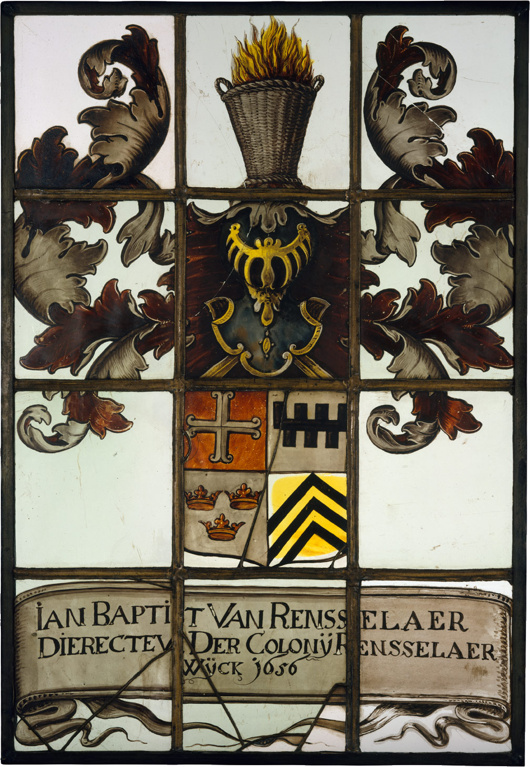
The patroonship of Rensselaerswyck was erected in 1630 giving its patroon, Kiliaen van Rensselaer, feudal powers over a large parcel of land on the banks of the Hudson River. Despite exercising a strong influence on the growth and development of New Netherland and the Hudson Valley, Kiliaen never actually stepped foot in the new world but kept close control of his domain from across the ocean in Amsterdam.
Jan Baptist was Kiliaen’s second surviving son, and served as director at the ‘colony’ as it was often known from 1652 to 1658. He commissioned Evert Duyckinck to make this painted-glass window displaying his coat of arms in 1656 and gave it to the Dutch Reformed Church in Beverwyck (today’s Albany).
While the congregation still exists — and celebrated its 375th anniversary in 2017 — the original church was demolished in 1805 and the window moved to the Van Rensselaer Manor House which itself survived til 1890 before facing the wrecking ball. The window was preserved and was left to the Metropolitan Museum of Art through the 1951 bequest of Mrs J. Insley Blair and while well documented it does not appear to be on display at the moment.
The patroonship itself was converted into a manorial lordship by the English authorities after they took over and survived until it was broken up amongst relatives after the death of Stephen van Rensselaer III in 1839.
This last great patroon had proved an indulgent lord and the efforts of his inheritors to claim uncollected back rents led to the 1839-1845 “Helderberg War” or “Anti-Rent War” of tenants revolting against the system. The great landholders, seeing the end was nigh, were convinced to sell up and in 1846 the state of New York adopted a new constitution abolishing feudal tenure. The era of patroonships and manors in the Hudson Valley had come to an end.
Neo-Classical New York
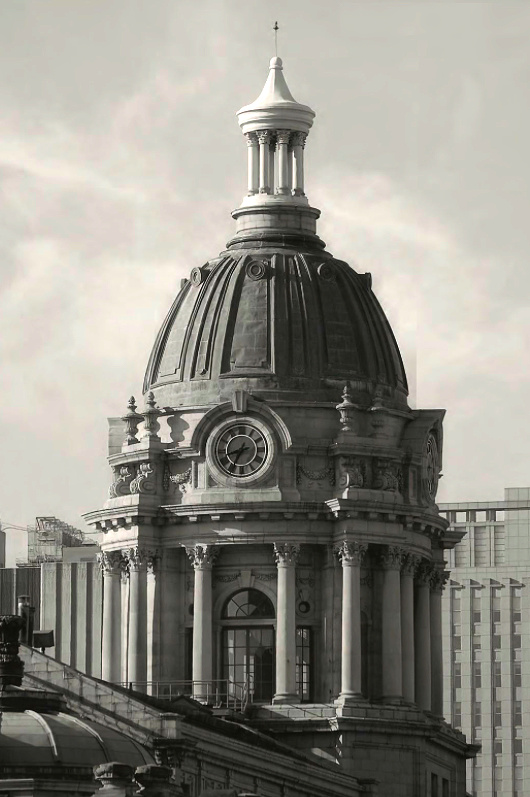
The dome of the old Police Headquarters Centre Street in New York.
More Dutch Flags of New York
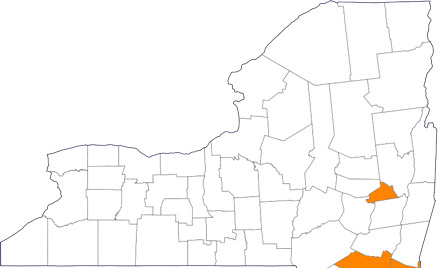
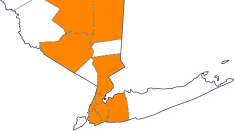
Areas shaded in orange are the counties of New York with Dutch-influenced flags
Natives and outsiders alike are often surprised when it’s pointed out just quite how much New York continues to be influenced by its Dutch foundation to this day, even though Dutch rule ended in the seventeenth century.
Previously I explored a number of local or regional flags in the state of New York that show signs of Dutch influence: those of the cities of New York and Albany, the Boroughs of Manhattan, Brooklyn, the Bronx, and Queens, and the counties of Westchester, Nassau, and Orange.
I’ve since found a few more counties to add to our survey of Dutch flags in the Empire State.

Dutchess County
One of the original counties of New York established in 1683, Dutchess retains the archaic spelling of Mary of Modena’s title while she was Duchess of York. Appropriately for a county that was until very recently largely agricultural, the county seal depicts a sheaf and plough, and sits on the county’s flag with its horizontal tricolour of orange, white, and blue.
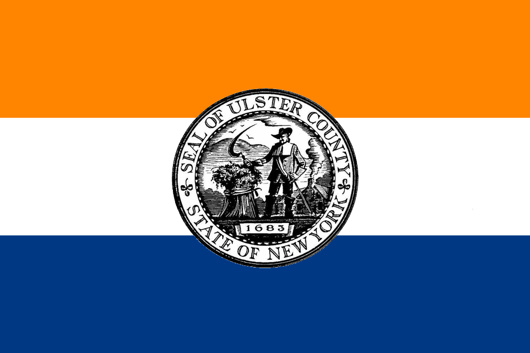
Ulster County
Across the Hudson from Dutchess County is Ulster, another of New York’s first counties. Its handsome seal features an early farmer wielding a sickle in front of a sheaf and a farmhouse, with the year of the county’s erection proudly included. The Dutch had begun to trade here as early as 1614, and the village of Wiltwijck was given municipal status by Peter Stuyvesant in 1663. Wiltwijck became Kingston in 1669 and remains a very handsome town today.
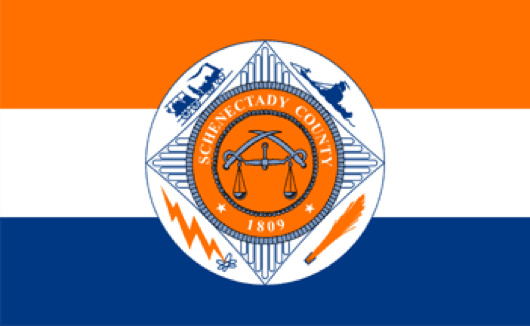
Schenectady County
The county of Schenectady is of later origin, 1809, and became industrialised in the latter half of the nineteenth century — the General Electric Company was founded here in 1892. Like Ulster and Dutchess, the county flag is just the seal displayed on an orange-white-blue tricolour.
The seal is a relatively boring depicting of crossed swords combined with the scales of justice, but on the flag it is depicted with a locomotive, canal boat, broomhead, and lightning bolt and atom.
St Nicholas, Our Patron
As by now you are all well aware, today is the feast of Saint Nicholas, the patron-saint of New York. His patronship (patroonship?) over the Big Apple and the Empire State date to our Dutch forefathers of old – real founding fathers like Minuit, van Rensselaer, and Stuyvesant, not those troublesome Bostonians and Virginians who started all that revolution business.
Despite being Protestants of the most wicked and foul variety, the New Amsterdammers and Hudson Valley Dutch maintained their pious devotion to the Wonder-working Bishop of Myra and kept his feast with great solemnity.
After New Netherland came into the hands of the British (and was re-named after our last Catholic king) the holiday continued to be celebrated by the Dutch part of the population, and was greatly popularised in the early nineteenth century by the publication of a curious volume entitled A History of New York from the Beginning of the World to the End of the Dutch Dynasty which purported to be by one Diedrich Knickerbocker.
In fact it was by Washington Irving, the first American writer to make a living off his pen, who did much to popularise St Nicholas Day in New York as well as to revive the celebration of Christmas across the young United States.
While, aside from hearing Mass and curling up with a clay pipe and a volume of Irving (being obsessive, I have two complete sets) here are a few links that shed some light on New York’s heavenly protector.
Historical Digression: Santa Claus was Made by Washington Irving
New-York Historical Society Quarterly: Knickerbocker Santa Claus
The History Reader: The 18th Century Politics of Santa Claus in America
The New York Times: How Christmas Became Merry
The Hyphen: Thomas Nast’s Illustrations of Santa Claus
– plus: Santa Claus and the Ladies
National Geographic: From Saint Nicholas to Santa Claus
Previously: Saint Nicholas (Index)
Knickerbocker Spires
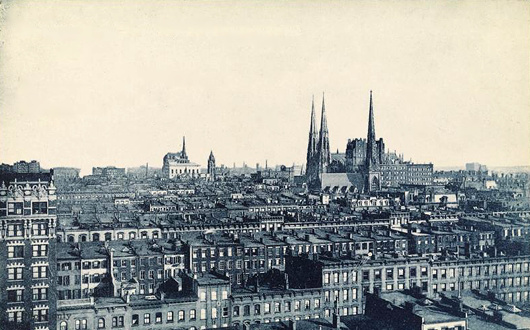
Before the age of the skyscrapers, New York’s church spires dominated the horizon and dwarfed their neighbours just like in the medieval towns and cities of the old world — as this photo from the 1900s shows.
Here St Patrick’s Cathedral holds court, with the St. Nicholas Collegiate Reformed Protestant Dutch Church poking up a few blocks down Fifth Avenue.
Slightly north on that same boulevard sits the grand renaissance palazzo of the University Club, with the spire of the Fifth Avenue Presbyterian Church poking up behind it.
Inside Governors Island
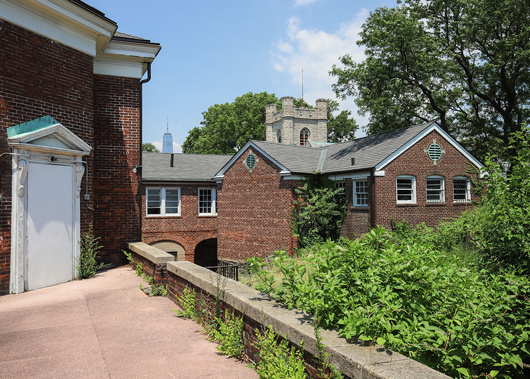
This intriguing little island in New York Harbour has always held something of a fascination for me — viz. articles previous on the subject. Aside from its interesting history there is the matter of the complete lack of foresight in ending its military use as well as the failure to imagine a future use suitable to its history and, if the word is not hyperbole, majesty.
Gothamist recently featured a new peek inside some of the abandoned buildings on Governors Island, a mere selection of which are reproduced here. (more…)
The Governor’s Room
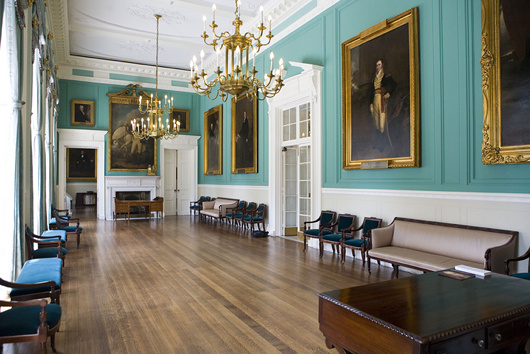
Pursuant to my post of John Bartlestone’s photographs of City Hall, I came across this photo the other day and it reminded me that this is still one of my favourite rooms in all New York. There’s something about that particular shade of green. I previously wrote about this suite of three rooms in 2006.
The above photo is by Ramin Talaie while below, in 2010, Mayor Bloomberg inspects a city flag being sent to a New Yorker serving in Afghanistan as reported by the Daily News.
The late & much-missed New York Sun also reported on the portraits hanging in City Hall in 2008.
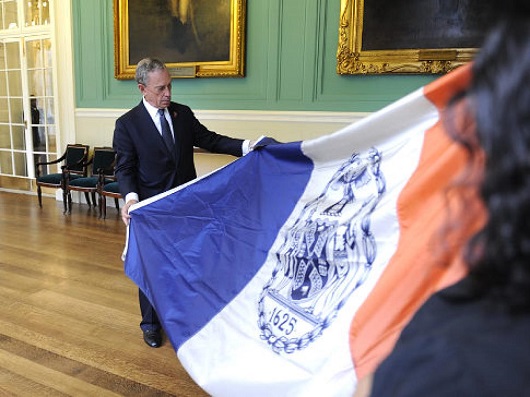
City Hall
These images of City Hall show the superb skill and eye for detail of the architectural photographer John Bartelstone — a licensed architect in his own right — and date from the completion of the most recent set of renovations in 2015.
Church of the Intercession
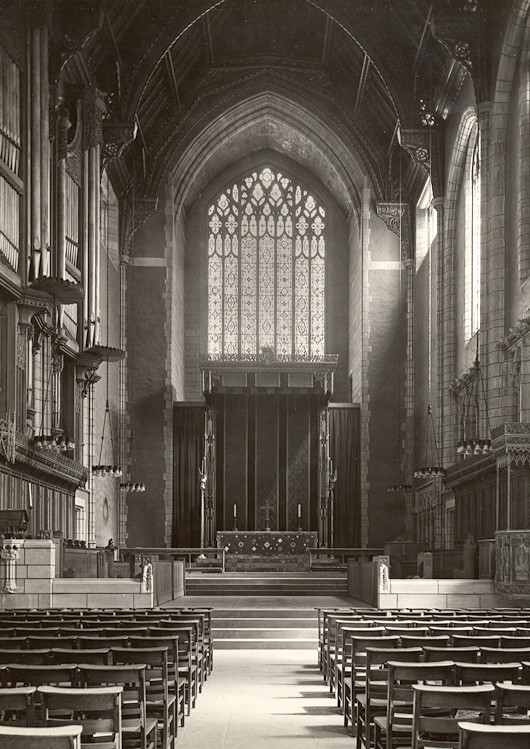
The huge and spacious interior of the Church of the Intercession, New York. One of Bertram Grosvenor Goodhue’s masterpieces; so much so that he decided to be interred in the north transept of the church.
Marinus Willett
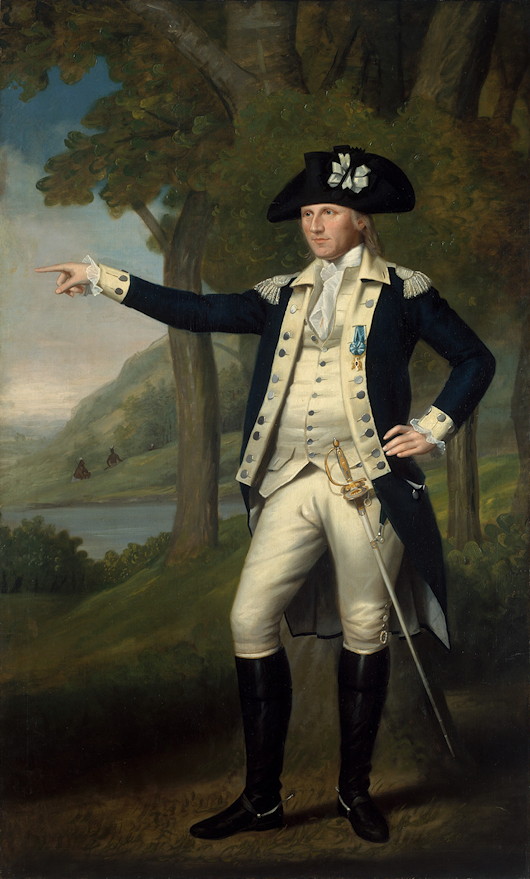
In one of the galleries of the Metropolitan Museum’s American wing, behind the Tuckahoe-marble façade of the old Assay Office (moved here from Wall Street), hangs this portrait of Col. Marinus Willett of the Continental Army’s 5th New York Regiment.
Born in 1740, the second of thirteen children, Willett attended King’s College before being commissioned a lieutenant in a New York provincial regiment during the Seven Years’ War (or French and Indian War as it’s known more locally). (more…)
Wall Street
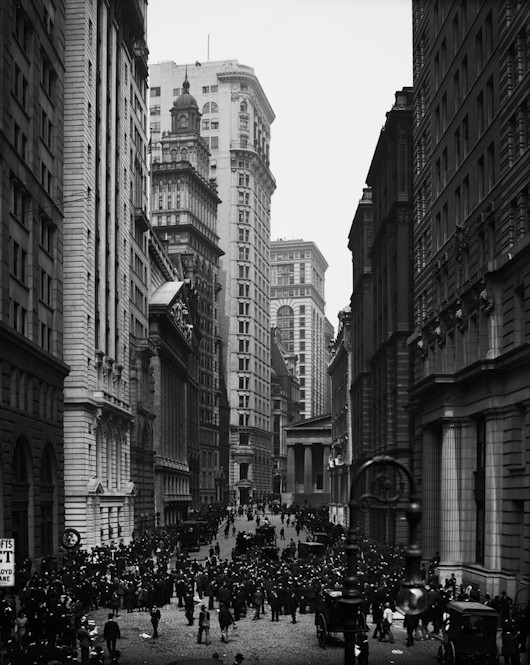
Well, actually it’s Broad Street looking down past the New York Stock Exchange to Federal Hall, which itself is on Wall Street.
Most of Broad Street was originally a canal (hence its width) but in 1676 it was filled in and laid out as a street.
The Old Dutch Church of Sleepy Hollow
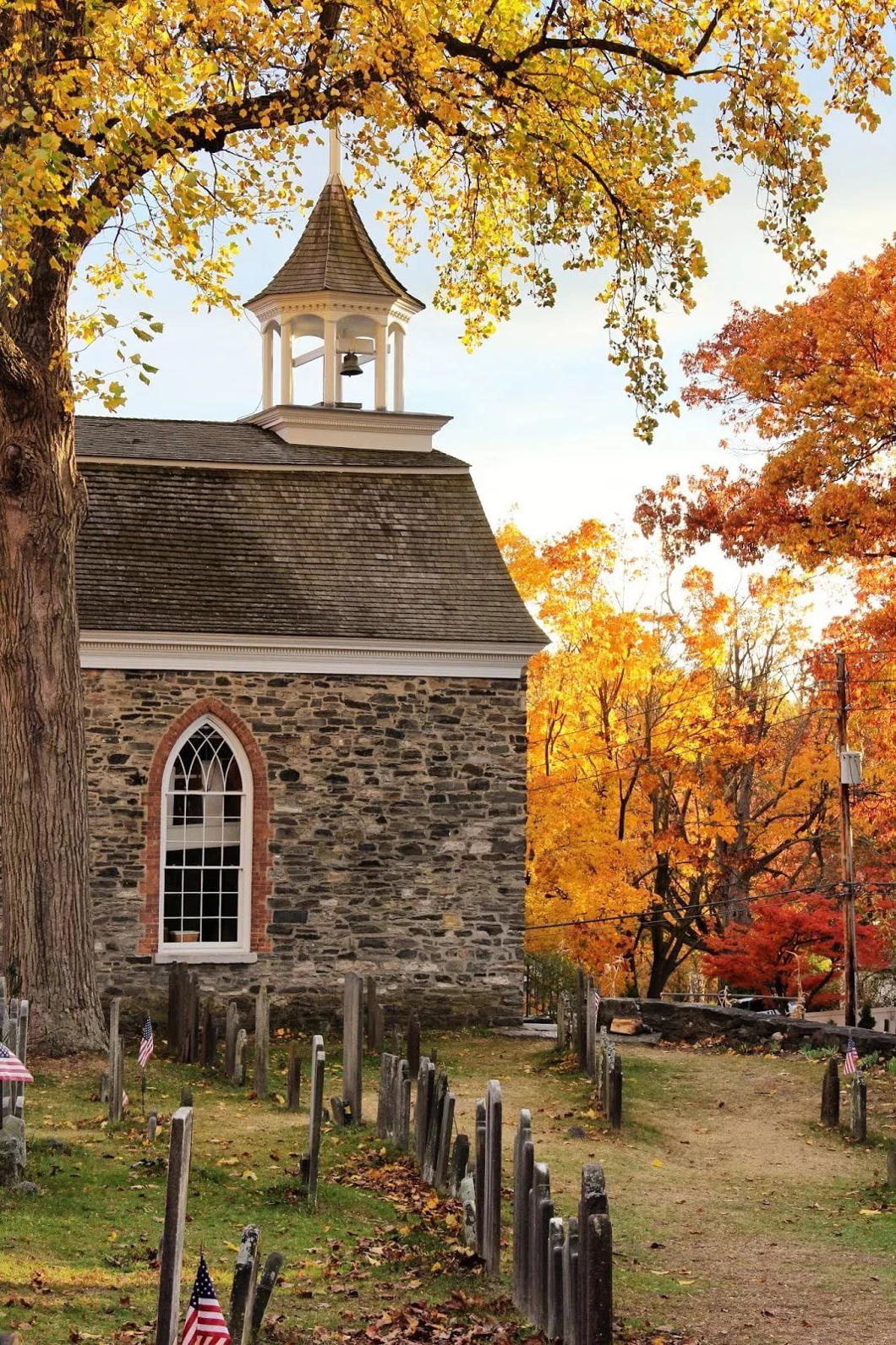
If there is any season which is plus New-Yorkaise que les autres then it must be autumn, and around the time of Hallowe’en in particular.
Thanks to the fertile imagination of Washington Irving, buried in the cemetery of the Old Dutch Church in Sleepy Hollow, the Hudson Valley is the spiritual home of this ancient Celtic feast now implanted in the New World.
The other day I dusted off the huge single-volume complete works of Irving – almost the size of an old Statenvertaling – and re-read his most famous tale, “The Legend of Sleepy Hollow”.
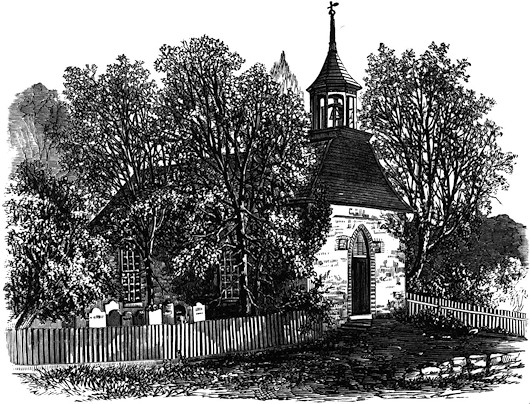
Irving describes the position of the Old Dutch Church:
The sequestered situation of this church seems always to have made it a favorite haunt of troubled spirits. It stands on a knoll surrounded by locust trees and lofty elms, from among which its decent whitewashed walls shine modestly forth, like Christian purity beaming through the shades of retirement. A gentle slope descends from it to a silver sheet of water bordered by high trees, between which peeps may be caught at the blue hills of the Hudson. To look upon its grass-grown yard, where the sunbeams seem to sleep so quietly, one would think that there at least the dead might rest in peace.
On one side of the church extends a wide woody dell, along, which raves a large brook among broken rocks and trunks of fallen trees. Over a deep black part of the stream, not far from the church, was formerly thrown a wooden bridge; the road that led to it and the bridge itself were thickly shaded by overhanging trees, which cast a gloom about it even in the daytime, but occasioned a fearful darkness at night. Such was one of the favorite haunts of the Headless Horseman, and the place where he was most frequently encountered.
The tale of the Headless Horseman is now, partly thanks to various popular reinterpretations of it, well known even outside the Hudson Valley. I remember as a wee lad growing up in that part of the world our Scout uniforms had a badge bearing the image of the “Galloping Hessian”.
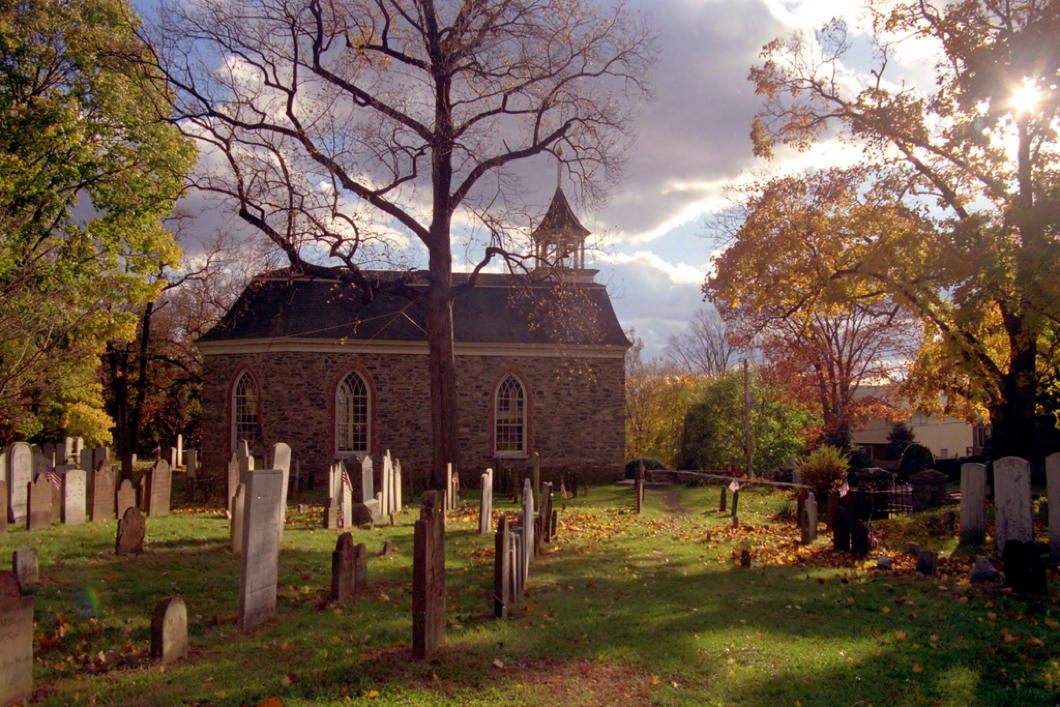
UNHQ
United Nations Headquarters, New York
AMONG THE LEGACIES of my New York childhood is a sentimental fondness for the United Nations, and especially for the stylish swank of its headquarters at Turtle Bay in Manhattan. The name of the small neighbourhood originates (scholars tell us) not from the turtles which were once abundant upon the shores of the island and its environs but rather from a small inlet shaped, in the eyes of the old New Netherlanders, like a particular type of bent or curved blade called a deutal knife in Dutch. The woods and meadows surrounding Deutal Bay were easily rechristened as Turtle Bay once the English established their ascendancy and New Amsterdam became New York.
Over the course of the eighteenth and nineteenth centuries the tiny port founded at the bottom tip of Manhattan grew further and further up the island, swallowing up the old colonial villages like Greenwich, Bloemendal, and Haarlem, or farms like Turtle Bay, Inclenberg, and Kip’s Bay, until as today there is just one giant urban mass stretching from the Battery at the bottom tip of the island all the way to Spuyten Duyvil at the top.
While New Yorkers like to think that there is no possible competitor to the city’s status as capital of the world, there was of course a great debate over where the United Nations should be based. Geneva was an obvious candidate, as the beautiful art-deco Palais des Nations provided a ready-made home for an international organisation. The fathers of the UN, however, did not want to associate themselves so closely with the failure of the old League of Nations the Palais was built for, and so the Geneva option was nixed.
Given the shifting balance of world power, it was thought a New World site might be a wiser choice than a European location. Quebec, as I have written previously, was an obvious possibility as the city is a beautiful melange of Old World and New, and for Europeans was easily accessible by passenger liner. Australia, New Zealand, and the Pacific states, however, were in favour of San Francisco for geographic reasons to their obvious benefit, and cited the Californian city’s hosting the 1945 Conference on International Organisation which brought forth the UN Charter.
Fears that the United States would refuse to participate fully in the UN (as with the League of Nations of old) almost guaranteed that the US permanently hosting the world body in order to solidify American resolve in the UN’s favour, but the squabble over precisely where dragged on. The Rockefeller family intervened by offering to the fledgling United Nations Organisation, at no cost whatsoever, a large riparian site at Turtle Bay on the banks of the East River, largely consisting of slaughterhouses at the time. Settled then, but what would the complex look like? (more…)
New Yorkers: See New York!
Old-School Ads Employed for City’s Internal Tourism Campaign
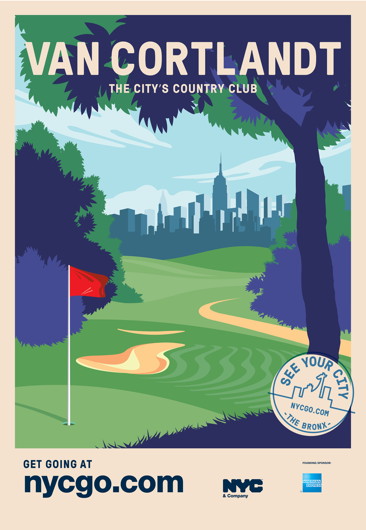
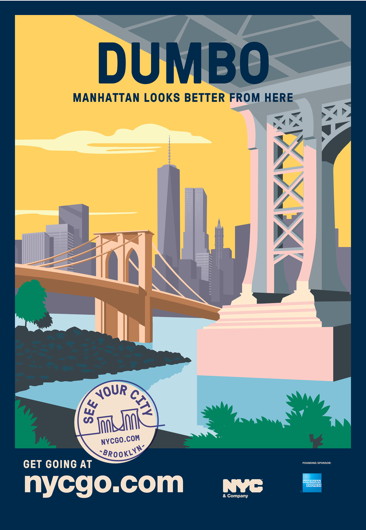
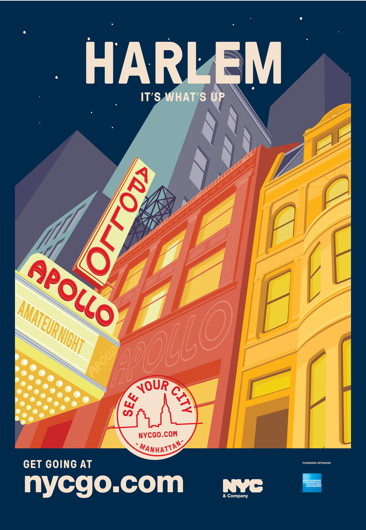
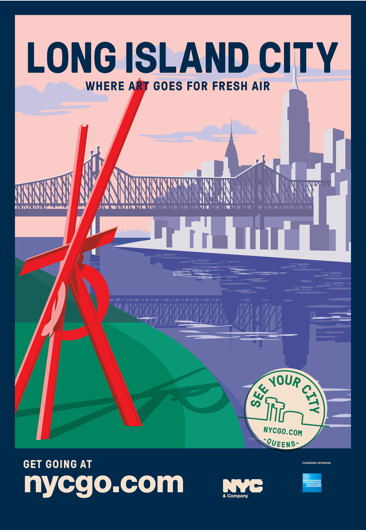
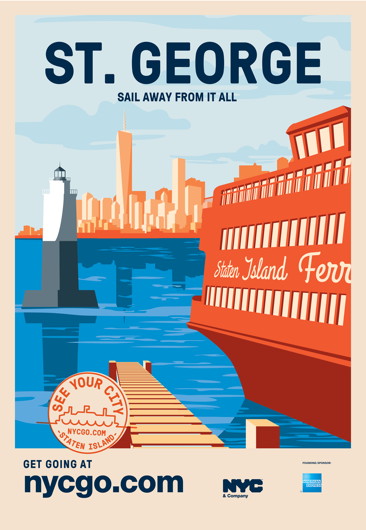
NYC & Company, the official tourism and marketing board of New York City, has cottoned on to the fact that in such a vast metropolis many parts of the city are virtually unknown to the natives of whichever particular borough.
They recently launched the ‘See Your City’ campaign encouraging New Yorkers to visit places perhaps less familiar to them within their own city. Part of the campaign involves the above series of posters for display in bus shelters.
The style evokes old-school travel posters of the 1920s & 30s, and NYC&Co commissioned one for each of the five boroughs.
Elsewhere: Adweek | New York Times | Untapped Cities | NYCgo
End of the Line for Rizzoli Bookshop
Another New York bookshop bites the dust
In New York, good things are only allowed to last a little while: eventually they must all be destroyed. The latest to add to the pile is the Rizzolli bookshop on West 57th Street, which has received notice that the landlords intend to demolish the 109-year-old structure in which the bookshop is housed.
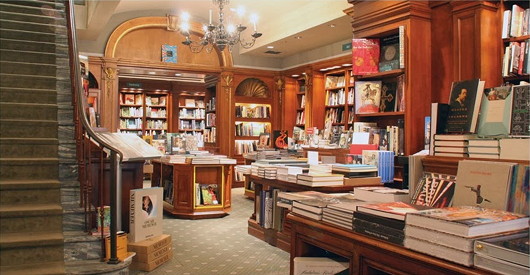
Rizzoli, publishers of some of the finest and most luxuriously printed books on the market, have not yet said whether they will be opening shop elsewhere.
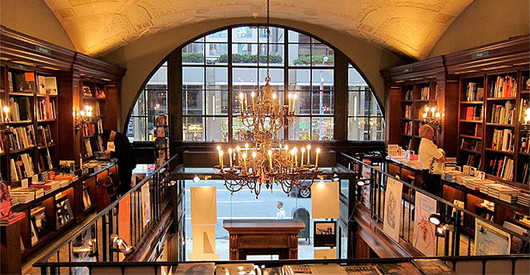
If so, it would be the second move for the shop, which opened in 1967 at 714 Fifth Avenue (below), just around the corner. A developer tried to tear that building down as well, but preservationists managed to have the façade, with its lalique glass, incorporated into the new tower. It’s now home to Henri Bendel.
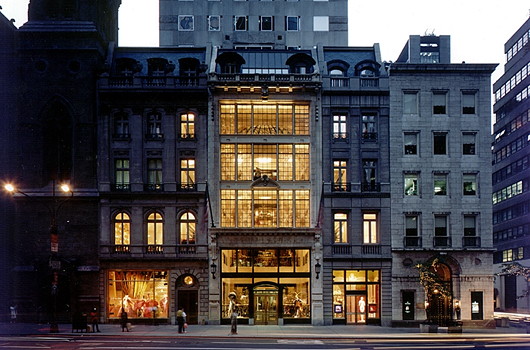
Other New York bookshops to close in recent years include the Librairie française, Coliseum Books, Gotham Book Mart, Urban Center Books, and further back more venerable institutions like Scribner’s and Brentano’s.
Top three photos: Mais Uma Pagina
The Cathedral of the Bronx
The Augustinian Church of St Nicholas of Tolentine
The Church of St Nicholas of Tolentine dominates the busy intersection of University Avenue and West Fordham Road in the Bronx. The parish was erected by the archdiocese in 1906 and has been served by Augustinians ever since then. The present church is a modern gothic creation from 1927, and probably one of the most handsome Catholic churches in the borough — it is often nicknamed “the cathedral of the Bronx”. (Though that style is sometimes also ascribed to St Jerome’s in Mott Haven).
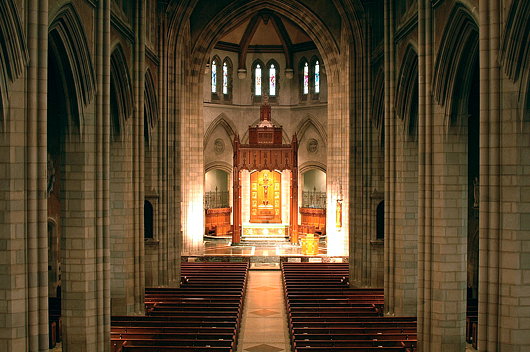
The church is of suitably grand proportions, but the effect is somewhat diminished by the unfortunate use of bulky wooden pews. They are ill-suited to such a large church, and detract from the spaciousness of the interior. This is unfortunately a very frequent problem in the United States, where clumsy pews crowd even great cathedral churches like St Patrick’s in Manhattan or the glorious Cathedral Basilica in St Louis. Regardless, St Nicholas of Tolentine is a splendid ornament in this borough of many churches. (more…)
Yorkville Promenade
One of the thorough-going irritations of New York is that, for all its glories, one can’t help but feel that the individual, the human being, is simply not the priority there. This intriguing and worthwhile proposal from Massengale & Co, Dover Kohl & Partners, and H. Zeke Mermell, if executed, would go a long way to making the Upper East Side of Manhattan a much more people-friendly place.
It takes its inspiration from the Ramblas of Barcelona, one of the greatest streets in the world. While their written proposal (below) is couched in anti-car talk, I frankly don’t care about reducing auto use in New York City. The much more important priority is increasing people places in the city; that is, increasing the amount of public space in which it is clear that people have priority. (This will almost certainly have the same effect as the intention of reducing auto use, I’ll concede.) The city has taken some admirable steps in that direction in recent years (the increasing in pedestrian-oriented spaces, including previously unheard-of outdoors tables and chairs for the use of all and any).
The Yorkville Promenade proposal for Second Avenue is eminently suitable to its particular place and location, especially coupled with making First and Third Avenues bi-directional. It is a worthy attempt to tame and civilise streets that all too often feel quite inhumane, and should be enacted.
Yorkville Promenade on Second Avenue
FOR SO MANY REASONS, we must reduce auto use in New York City. Studies for Mayor Bloomberg showed that living on a high-traffic avenue in Manhattan is un-healthy, particularly for our children. To add insult to injury, 80% of Manhattan residents do not own cars, and only 20% of our out-of-town commuters drive to work. Our ugly, unhealthy avenues are more for the benefit of others than Manhattan’s workers and residents.
Most Manhattanites live in small apartments and spend a lot of time in public life. When the weather is nice, we spend lots of money to dine next to places designers call “auto sewers”: noisy, smelly streets made to move cars quickly, with wide, one-way lanes and no parking at rush hour so that the speeding cars and trucks are inches from the sidewalk. It doesn’t make much sense.
Then there are the problems of Climate Change and Peak Oil. We have built our way of life on an inexpensive but non-renewable resource that is simultaneously starting to run out, becoming more expensive than we can afford and changing the earth for the worse.
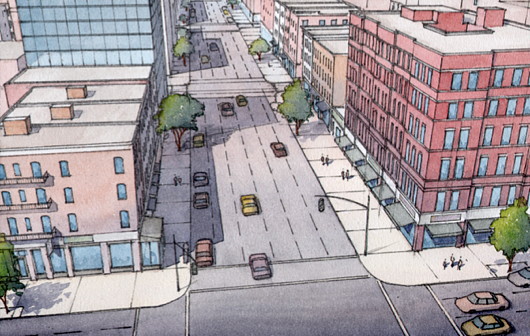
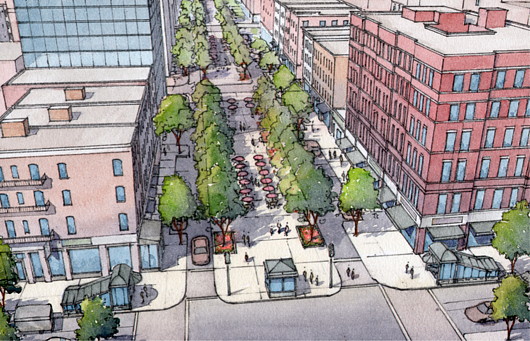
The New Yorkville Ramble
The Yorkville Ramble is an idea for a new way to rebuild Second Avenue, after the completion of the new subway under construction below the avenue. Inspired by the famous Ramblas of Barcelona, the design gives the center of the wide avenue that was once two-way to a new car-free linear park for walking, biking, sitting, dining and people watching. Cafés and restaurants along Second Avenue would be licensed to have tables on the center island. Narrow traffic lanes and short term parking lanes to each side would let cars and deliveries come and go while eliminating speeding traffic from Second Avenue.
Construction would be timed to work with the construction phasing for the subway, which will initially run from Sixty-Third Street to Ninety-Sixth Street. The Ramble would be a special place that enlivens the Manhattan grid, like Broadway on the Upper West Side and Park Avenue on the Upper East Side, with a vibrant street life unlike staid Park Avenue.
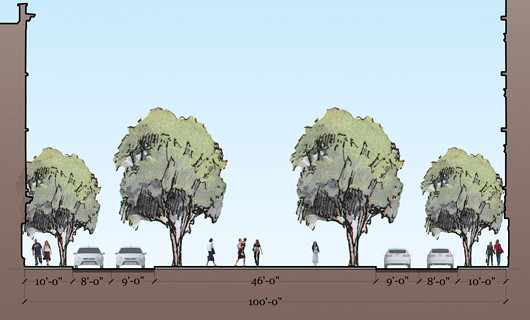
WEST OF THIRD AVENUE ON THE UPPER EAST SIDE, the introduction of Madison and Lexington Avenues into the normal city grid produced shorter blocks that made the grid more interesting for pedestrians and thereby increased the value of the real estate.
Yorkville’s longer blocks are less pedestrian-friendly, and Second and Third Avenues both used to have that New York oxymoron–the elevated subway–depressing real estate values and building quality for decades. In recent decades the area has boomed, and the Yorkville Ramble will give it a linear neighborhood center unique in New York City, drawing from both the neighborhood and the access provided by the new subway line.
Proposed Congestion Zone
Mayor Bloomberg and the New York City DOT have proposed a congestion zone for the city. London’s congestion zone shows that roads like the Second Avenue design proposed by the DOT will then be oversized and inappropriate for the amount of traffic they will have. First and Third Avenues could go back to being two-way, as they once were, and traffic would move in a more civilized fashion. We don’t need to make express auto routes in and out of the city when we have the best mass transit in the country.
The bicycle lane in the DOT’s new design for Second Avenue is a good idea, but the design for the road shown above is still a traffic engineer’s dream, with wide, one- way lanes and no parking shielding the pedestrian from the speeding cars, buses and trucks. Studies show that walkers don’t like the visual clutter of all the signs and multi-color lanes that the engineers want. Walkers also of course want wider sidewalks.
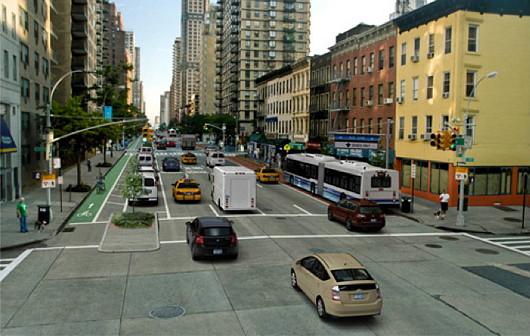
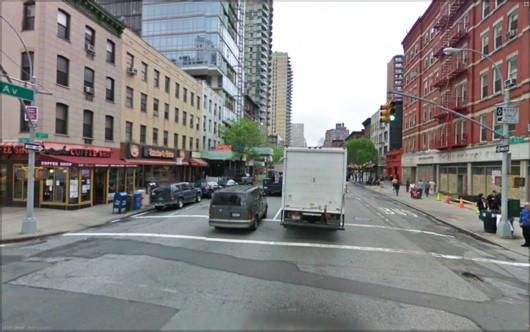
Conclusion
Second Avenue is currently torn up for the subway con- struction and its rebuilding will start in the next few years. Combined with changing attitudes and perceptions about the car in the city, that makes now the perfect time for a humane and beautiful new type of post- auto road for New York.
Choral Concert in N.Y.
Manhattanites and denizens of the neighbouring boroughs and counties might be used to going to the Church of St Thomas on Fifth Avenue to hear the best choir in New York, but this evening the house of worship is hosting the Westminster Cathedral Choir, the best choir in London. If you haven’t made plans for the evening, there are still tickets available here.
Tonight’s concert will feature some Victoria, some Elgar, some Guerrero, and more, but most appealing to me is the Christus vincit by James MacMillan — Scotland’s greatest living composer. If you share my tastes, you avoid music by any composer who hasn’t been dead at least half a century, but MacMillan is good enough to be elevated to the realms of the honorary deceased. He’s also commented on this blog in the past!
Search
Instagram: @andcusack
Click here for my Instagram photos.Most Recent Posts
- Burns Tower April 19, 2024
- Patrick in Parliament March 18, 2024
- Articles of Note: 13 March 2024 March 13, 2024
- Cambridge March 9, 2024
- Taken on Trust March 4, 2024
Most Recent Comments
Book Wishlist
Monthly Archives
Categories



